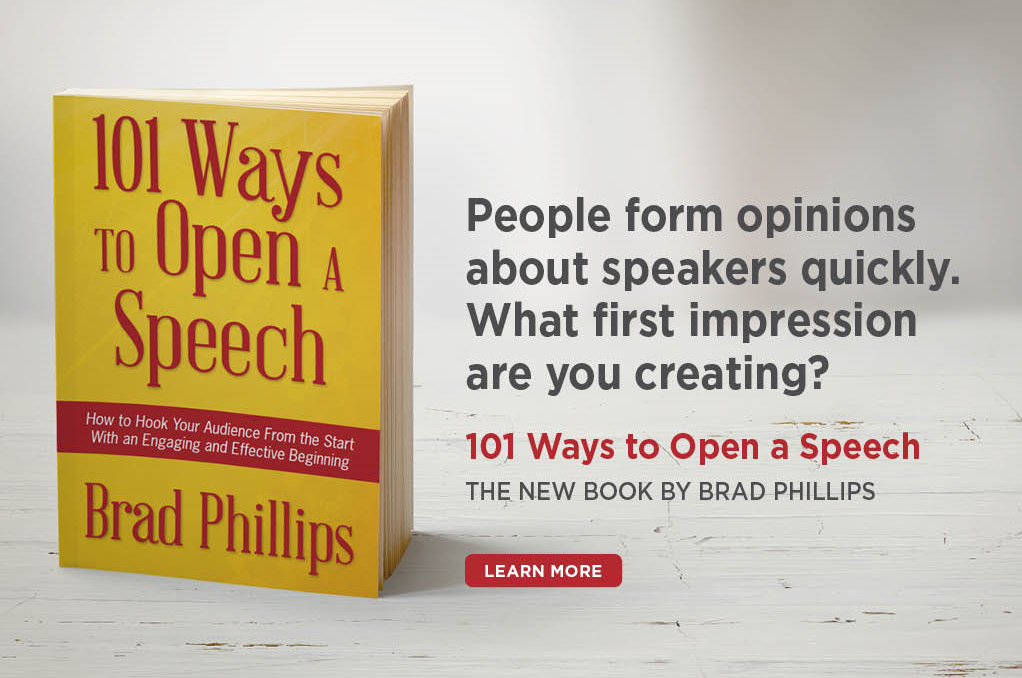Seven Great Ways To Close A Speech (Part One)
Throughout my career, I’ve seen hundreds of speakers end their presentations in exactly the same way.
They click to their last slide, deliver the information on the screen, and limp to the finish line by mumbling something such as:
- “So feel free to call me with any questions you might have.”
- “That’s the end of my presentation.”
- “Thank you for listening.”
- “Do you have any questions?”
- “Ummm…thanks.”
A speech’s close is one of its most important parts, but it may also be the most neglected. The close is your final opportunity to accomplish your goal, whether it’s to inspire the audience, drive an action, inform a community, break the status quo, or change an opinion.

Over the next three days, you’ll learn seven great ways to close a speech, each with an example. Today, we’ll begin with two of the most popular closings: the summary and the bookend.
Note that you may want to also include a call-to-action in your close, which I’ve written about here.
Close One: Deliver a Summary
You may have heard the old public speaking adage that advises speakers to use a three-step approach: “Tell them what you’re going to tell them, tell them, and then tell them what you’ve told them.”
You don’t need to follow that rigid rule for every presentation you ever give. But you’ll probably use something similar to it the majority of the time, particularly in the “summary” close.
In the summary close, you’ll finish your talk with a synopsis that reminds the audience of your goal and your most important points. For example, let’s say you’re an advocate for children’s safety that is trying to increase the percentage of parents who use child safety seats for their kids. You might end your talk by saying something such as:
“In conclusion, we’ve made significant strides in protecting children. Our education campaign significantly helped increase the number of parents who use child safety seats for their children. And our work with the state legislature resulted in laws that now allow police to ticket and fine parents who don’t.
As a result of our work, the biggest issue is no longer making sure that parents install safety seats. Rather, it’s making sure that they do so correctly. One recent study found that as many as 90 percent of all safety seats are installed improperly, which increases the odds that a child will be unnecessarily hurt or killed in an auto accident.
Therefore, I’m recommending a new campaign that shifts our focus from installing safety seats to installing safety seats correctly. This new campaign would encourage parents to use a state- approved installer instead of trying to install the seat themselves. I believe this is the logical next step in our efforts to protect kids in our state, and that this strategy shift will yield tremendous results.”

Close Two: Bookend Your Beginning
Just as matching bookends are often used at beginning and end of a row of books, matching speech bookends use the same opening and closing device at the beginning and end of a presentation.
For instance, let’s say you opened a speech to a group of part-time volunteers who are working to reduce the number of injuries suffered in house fires like this:
“I’m only going to speak to you for one hour this morning. During our hour together, someone, somewhere in America, is going to be badly injured in a house fire. By the time you begin lunch this afternoon, someone, somewhere in America, will die in a house fire. By dinner, another person will die. By the time you go to sleep, another person will die. As you sleep tonight, two more people will die.
I’m here today because I want to prevent that from happening. And I’m going to need your help.”
You could “bookend” your talk by ending with the following close:
“We’ve been together nearly an hour. That means that someone, somewhere in America, was just badly injured in a house fire. And we’re an hour closer to lunch, which means someone is about to perish in a house fire.
Your work matters. Because of your passion, you’re going to prevent someone from getting hurt. You’re going to spare a family from having to mourn a husband, a wife, a sister, a brother, or a child. And next year, when we meet again, I hope that because of your work, I’m unable to open my speech with the same tragic statistics that I used at the beginning of today’s session.”
Click here to read part two of this series and here to read part three. And click here for eight great ways to open a speech.
Have the best of the blog delivered to your inbox twice per month! Enter your name in the box below to join our mailing list.



awesome… wonderful…. great job…. please keep up the good work…..